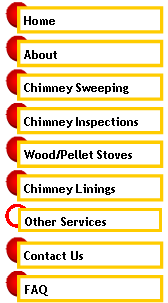Water Issues
Water is the number one problem with chimneys in the United States (www.csia.org). It causes more damage than any other issue with a chimney. Keeping the water out of the flue system and your chimney will help you to avoid major repair costs later on down the road. There are four main ways to keep water out of your chimney.
1. Chimney Caps are designed to keep any potential sparks or flying embers in the flue instead of on your roof. A chimney cap also helps to keep the rain as well as animals (such as squirrels, raccoons, and birds) out of your chimney. Chimney caps come in many different shapes and designs. We typically install customized stainless steel (or copper) caps that are precisely measured to fit your chimney. We can also build chimney caps out of blue stone, or for a restoration project, we can build a Bishop’s style chimney cap.
2. Waterproofing a chimney is a preventative maintenance measure that will help prevent water from bleeding through the brickwork and into the chimney flue, which could then end up in a fireplace, along an interior fascia wall, or puddle on the basement floor. We use a product from Saver Systems (www.chimneysaver.com) called Chimney Saver®. This is a permeable solution that prevents rain water from getting inside the chimney but also allows the chimney to release any water that may have built up inside the flue from condensation. Chimney Saver® is warranted by the manufacturer for 10 years.
3. Flashing a chimney properly is very important for keeping out water. From what we have seen, most chimneys are not flashed properly. When the roof is installed, there should be a protective layer of ice and water shield around the chimney. When the roof shingles are installed, a 5” x 7” aluminum flashing (also called step flashing) should be weaved into the shingles. The flashing (this can be lead, copper, or tin) on the outside of the chimney should not be weaved into the shingle; it should lie on top of the shingle. If the flashing is weaved in, then it will lift the shingle, providing a place for water to penetrate. Using tar to help prevent leakage around the chimney is also a short-term fix. If you see tar on your chimney, then at one point in time, there was a leak, and unfortunately, it will leak again if not properly fixed. Tar is a temporary fix because it will eventually crack, dry out, and fall off (usually within 2-5 years depending upon the amount of sun it receives), whereas a properly flashed chimney should last as long as the house does.
4. Crown Sealing seals cracked chimney crowns. Chimney crowns can be damaged by severe weather or thermal stress, causing cracks that allow water to deteriorate the masonry and clay flue ties. We use a product from Saver Systems called CrownSeal® which is an elastomeric coating that forms a flexible, waterproof membrane to protect the chimney crown. CrownSeal® is warranted by the manufacturer for 10 years.
Minor Masonry
Minor masonry repairs usually involve re-pointing a chimney. Re-pointing a chimney involves filling in the gaps with mortar between the bricks. These gaps are usually caused by weather exposure. Re-pointing a chimney helps to maintain its structural integrity so that the bricks do not become loose and fall out.
Chimney Rebuilding
We rebuild both brick and block chimneys. We do not rebuild stone chimneys. When deciding if a chimney needs to be rebuilt versus re-pointed, we inspect the chimney to determine if it is structurally sound based on how much mortar is missing and if the chimney can withstand re-pointing. When rebuilding a chimney from the roof tile up, we will se up some type of staging with or without additional roof staging depending on the size of the job and the safety of the workers. Normally, we will remove the old lead flashing and install new lead flashing with aluminum counter flashing. We will match the existing brick type and mortar color as much as possible, although sometimes the original brick used is no longer being manufactured. When rebuilding a concrete block chimney, we will take it down to a point where the chimney is solid. Most block chimneys deteriorate over time because of water penetration (block is a very porous substance). For block chimneys, we often recommend waterproofing the chimney with Chimney Saver® to help eliminate water penetration so that the chimney will last longer.
Fireplace Repairs
There are many different ways to repair a fireplace. Most fireplaces have a firebox made with special brick called firebrick. Firebrick are made of refractory material to withstand a tremendous amount of heat. Over time these firebrick can crack and deteriorate, especially when the fireplace is used frequently. When we have to rebuild a fireplace, we like to give you options on how you want your fireplace to look and perform. Most fireplaces do not give out a lot of heat, making them very inefficient. We can rebuild your fireplace to give you more heat then it originally did. One option is to rebuild the firebox so that it is more like a “Rumford” fireplace. We specialize in “Rumford”-type fireplaces and can reconfigure an existing fireplace into a “Rumford” fireplace. A noticeable feature of a “Rumford” fireplace is they have shallow fireboxes with angled side coverings which can throw heat back into the room and cause less air turbulence. In most older houses here in New England, we find “Ortin-type”Rumford” fireplaces, in which the back wall angles in about half way up the firebox and also has a smoke shelf. Other types of firebox designs include a “Rosin-type” firebox, where the side covings are similar to a “Rumford” but the back wall starts straight up and then rolls forward and then back again into the smoke chamber, and a “Prior Fire,” which is similar to a Rosin firebox. These types of fireplace designs are more efficient and throw more heat into the living area.
Pre-Fabricated Fireplace Repair & Installation
We can repair pre-fabricated fireplaces, which are most often found in condo units. The panels or boards in a pre-fabricated fireplace are made up of refractory material and are cast particular to the fireplace type. Each pre-fabricated fireplace manufacturer has its own specific replacement parts. Pre-fabricated fireplaces usually last about 20 years before they need replacing.
We also install cast refractory fireplaces for those instances where the existing fireplace was incorrectly constructed or when someone is looking for the most efficient fireplace system. One system is called the “Ahrens-Fire.” This is a specially designed complete fireplace system for restoring an old fireplace that does not meet today’s building codes, or it can be installed during new construction. Installing an Ahrens-Fire system is currently the only fireplace restoration product that meets or exceeds the Underwriters Laboratory safety testing criteria at zero clearance to combustibles. For more details on this unit, visit www.ahrenfire.com. The other type of cast refractory fireplace system is called “Bellfire” fireplace. Like the Ahrens-Fire, the Bellfire can be installed during new construction or to retrofit an existing fireplace. The Bellfire design allows for complete combustion, practically eliminating the buildup of creosote. For more details on this unit, visit www.bellfiresusa.com. Both these fireplace units are more efficient than a standard masonry-type fireplace or even any of the specialty fireplaces like a “Rumford.”
Dampers
There are many different types of fireplace dampers available, for those times when the existing damper is not functioning properly. Sometimes we can repair the existing damper, and other times, it needs to be replaced. There are even some occasions, particularly in very old homes, where there is no existing damper. One type of damper replacement is a top mount damper that is mounted at the top of the chimney. It has a stainless steel cable that mounts into the firebox area for operation. A top mount damper is a good option for many folks because they are less costly than removing and replacing the existing damper one.
Pre-fabricated Chimneys
We install all types of pre-fabricated chimneys to meet your particular needs. A pre-fabricated chimney is commonly used for fireplaces, wood stoves and some heating appliances. Below are some descriptions of the different types of vents for each type of need:
· A pre-fabricated chimney for an oil appliance is known as a Class “A” chimney, or commonly called a metalbestos chimney. “Metalbestos” is actually a specific manufacturer’s brand name. These types of chimneys are manufactured with a mass insulation between two sleeves of stainless steel, and they must meet UL 103 HT standards for solid fuel.
· Another type of pre-fabricated chimney is used specifically for pre-fabricated fireplaces. These types of chimney are specifically designed with their own particular pipe by each manufacturer. Each manufacturer UL tests their pipe with their own fireplace system as a whole; therefore, one manufacturer’s pipe should not be replaced with that from another manufacturer. Most of the pre-fabricated fireplace chimneys are air-cooled type chimney vents.
· B-vent is used for gas installations (furnaces, heaters, and boilers). Another type of pre-fabricated chimney is called L-Vent, which can be sued for high efficiency gas or oil furnace venting.
|


